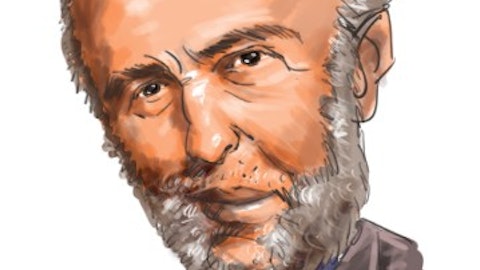Nomura Holdings, Inc. (NYSE:NMR) Q3 2023 Earnings Call Transcript February 1, 2023
Operator: Good day, everyone, and welcome to today’s Nomura Holdings Third Quarter Operating Results for Fiscal Year Ending March 2023 Conference Call. Please be reminded that today’s conference call is being recorded at the request of the hosting company. During the presentation, all the telephone lines are placed for listen-only mode. A question-and-answer session will be held after the presentation. Please note that this telephone conference contains certain forward-looking statements and other projected results, which involve known and unknown risks, delays, uncertainties and other factors not under the company’s control, which may cause actual results performance or achievement of the company to be materially different from the results, performance or other expectations implied by those projections.
Such factors include economic and market conditions, political events and investor sentiment, liquidity of secondary markets, level and the volatility of interest rates, currency exchange rates, security valuations, competitive conditions and size, number and timing of transactions. With that, we would like to begin the conference. Mr. Takumi Kitamura, Chief Financial Officer. Please go ahead.
Takumi Kitamura: Good evening. This is Takumi Kitamura, CFO of Nomura Holdings. I will now give you an overview of our financial results for the third quarter of the fiscal year ending March 2023, using the document titled Consolidated Results of Operations. Please turn to Page 2. Group wide net revenue for the quarter was JPY393.7 billion, up 24% from last quarter. As you can see on the right, income before income taxes increased 165% to JPY83.6 billion, underscoring a rebound in performance since bottoming out in the first quarter. Net income was JPY66.9 billion. EPS was JPY21.5 and ROE came in at 8.5%. The market was clouded by uncertainty in October as central banks in Europe and the U.S. shifted to monetary tightening and concerns grew over a recession.
This gradually eased as the pace of rate hikes slowed, and there was a pause in appreciation of the U.S. dollar, leading to higher risk appetite among investors and a rally in equity markets. December brought a surprise move from the BOJ in yields curve control. Investors rushed into the bank and insurance sectors while selling real estate and export related stocks. The yen appreciation and the bear market prompted investors to buy on the dips, and sales increased as expectations rose over a revival in Japanese equities. So on the whole, we saw an improvement in investor sentiment during the quarter. Amid this backdrop, three segment income before income taxes rose 43% to JPY44.7 billion, as shown on the bottom right, driven by a rebound in retail and investment management.
Income before income taxes from outside the three segments was JPY38.9 billion. In December, we sold a part of our stake in Nomura Research Institute and booked a realized gain of JPY28 billion, which is mostly included here. Before turning to results for each business, I will briefly touch on performance for the nine months to December. Please turn to Page 3. As I said, market uncertainty eased during the third quarter and investor risk appetite increase. But looking at the nine months compared to the same period the year before, market activity was generally sluggish across many product lines. Groupwide net revenue was roughly flat at JPY1,010.6 billion, supported by the precipitous drop in the yen. However, income before income taxes declined 28% to JPY126.8 billion, and net income slumped 24% to JPY85.4 billion.
EPS was JPY27.44 and annualized ROE was 3.8%. As you can see on the bottom right, three segment income before income taxes declined 45% to JPY94.4 billion. Retail reported a slowdown in flow revenues, mainly from stock and investment trusts, while investment gain loss in investment management worsened. Conversely, retail recurring revenue and investment management business revenue, which represents stable revenues were both higher compared to the previous year. In Wholesale, the investment banking revenues slowed as corporates postponed share issuances and performance in our equities business was muted. Fixed income booked stronger revenues driven by the macro business. We also reported an improvement in gain loss related to transactions with a U.S. client in 2021.
As a result, Wholesale income before income taxes increased 16% year-on-year. Let’s now take a look at each business, starting with Retail on Page 6. By the way, the percentages I refer to from now on are all quarter-on-quarter comparison. Net revenue in Retail increased 12% to JPY81 billion. Income before income taxes grew 142% to JPY13.3 billion. By strengthening our segment based approach and providing detailed consulting services tailored to each client’s needs and the changing market conditions, we were able to increase flow revenue by 22% driven by sales of stocks, investment trusts and foreign bonds. Recurring revenue was flat, but our recurring revenue cost coverage ratio remained at 50% as overall revenues increased, and we maintained expenses.
Please turn to Page 7 for a breakdown of sales by product. Total sales for the quarter increased 7% to JPY4.9 trillion. Sales of stocks became more active each month as the market rebounds improved investor sentiment and retail investors bought on the dip in December. U.S. growth stock funds and high yield funds topped sales of investment trusts on the back of expectations for growth at U.S. corporates and higher bond yields. Sales of insurance products also increased as we made successful proposals for solutions for retirement funds and estate planning needs. Please turn to Page 8 for an update on KPIs. Net inflows of recurring revenue assets shown on the top left, increased slightly to JPY7.6 billion as there was a large investment trust redemption by corporate clients.

Photo by Towfiqu barbhuiya on Unsplash
Excluding corporate clients, net inflows were JPY190 billion, with contributions from discretionary investments, insurance and loans. As you can see on the upper right, recurring revenue assets stood at JPY18.1 trillion at the end of December, down due to market factors, although recurring revenue remained flat. Please turn to Page 9 for Investment Management. Net revenue increased 118% to JPY57 billion. As shown on the bottom left, business revenue, which represents stable revenues, increased by 5%. The Asset Management business remains solid and Nomura Babcock & Brown performance improved on the back of a recovery in the operating environment for aircraft leasing. Investment gain loss was JPY25.6 billion, a significant improvement compared to negative JPY3.7 billion last quarter.
American Century Investments gain loss made a substantial contribution and Nomura Capital Partners reported unrealized gains and recognized realized gains on the exit of some private equity investments. Expenses increased 15% to JPY23.7 billion due to share sales and the origination of aircraft leases. And these are transaction related costs, which won’t occur every quarter. Income before income taxes was JPY33.3 billion, the highest level in six quarters. Now turning on to Page 10. As shown on the top left, assets under management were JPY64.7 trillion at the end of December, down JPY100 billion due mainly to market factors. Net inflows on the bottom left show outflows of about JPY100 billion from the investment trust business due to JPY350 billion of outflows from ETFs. MRFs, where retail investors talk idle funds, reported inflows of JPY200 billion, and core investment trust also booked inflows of JPY44 billion.
The Investment Advisory business reported inflows of JPY57 billion on inflows into foreign stock funds in Japan. As shown on the bottom right, alternative assets under management declined due to yen appreciation, but inflows continued. Please turn to Page 11 for Wholesale. Net revenue declined 8% to JPY189.1 billion. As shown on the bottom left, Global Markets revenues slowed by 15% to JPY154.3 billion, mainly due to a slowdown in rates and ForEx emerging markets. Investment banking revenues increased 24% on a recovery in the Japan ECM business. Expenses were JPY190.9 billion, up 3% due to yen depreciation, severance related expenses, platform enhancements and professional fees. As a result, loss before income taxes was JPY1.9 billion. Please turn to Page 12 for an overview of business line performance, starting with Global Markets.
Net revenue declined 13% to JPY154.3 billion. Fixed income dropped to 25% to JPY86.7 billion. Macro products had a particularly slow quarter. Although rates revenues increased in EMEA for both the flow and structured businesses, agency mortgages in the Americas declined. ForEx emerging market in AEJ slowed from last quarter, which was the best in about six years. Spread Products revenues increased primarily in AEJ as China’s economy reopened, but securitized products slowed due to muted client activity. Equities revenues increased 9% to JPY67.5 billion. Execution services revenues increased in Japan and the Americas due to primary transactions and a rebound in market volumes. We also recognized JPY9.1 billion in revenues related to prior transactions with the U.S. clients.
Please turn to Page 13 for Investment Banking. Net revenue increased 24% to JPY38 — JPY34.8 billion. Advisory remained solid despite a slowdown in global fee pools as M&A completed transactions and equity private placement transactions in the Americas contributed to revenues. As you can see here, revenue from financing and solutions improved markedly due to factors, including a rebound in Japan ECM and strong performance in the Solutions business for equities, rates and ForEx on demand for hedging a mid-market volatility. Please turn to Page 14 for an overview of non-interest expenses. Groupwide non-interest expenses increased by JPY24 billion to JPY310.1 billion, of which about 30% is attributable to yen depreciation. Other factors include compensation and benefits being impacted by severance related expenses in Wholesale.
Other expenses increased by 32% due to a rise in professional fees related to transactions and because provision reversals related to progress in legacy transactions kept expenses down last quarter. Finally, please turn to 15, Page 15 for an update on our financial position. As shown on the table on the bottom left, Tier 1 capital was JPY3.2 trillion, down JPY36 billion from the end of September due to lower ForEx transaction value as the yen rose. Risk weighted assets rose by JPY770 billion from the end of September to JPY17.9 trillion. The waterfall graph on the bottom right shows credit risk declined by JPY460 billion, but market risk increased by JPY1.2 trillion due partly to a temporary increase in our position due to credit split widening and transaction origination.
As a result, our Tier 1 capital ratio at the end of December was 18.1%, and our CET1 capital ratio was 16%, both lower than at the end of September. That concludes the overview of our third quarter results. This quarter, we finally saw market-to-market valuations turned positive after dragging down our results from the past three quarters. This, combined with the realized gain from selling shares in an affiliate company substantially lifted groupwide earnings. In our core business, we started to see an improvement in sentiment among investors and corporates and retail and investment banking revenues rebounded, giving us an ROE of over 8% for the first time in four quarters. Retail performance in January got off to a slightly slow start compared to revenue levels in the third quarter, but we are starting to see a bullish stance towards Japan equities as expectations grow over the reopening of the economy.
Demand for a newly launched investment trust reopened Japan has been higher than expected. In Wholesale, fixed income, particularly macro products struggled in third quarter, but bottomed out in October and has been recovering. Overall, wholesale has gotten off to a good start in January. While maintaining this business momentum, we will manage cost stringently. As we said at our investment forum last year, we are working towards JPY20 billion in cost reductions in retail by end of March 2025. In Wholesale, we will see the impact of inflation globally, but we are reviewing our cost base in line with the current business environment, and we will continue to do so. This year, we expect inflation concerns and geopolitical risks to continue and we must remain vigilant.
We will manage risk prudently while providing liquidity and solutions for our clients. Thank you.
See also 12 Best Dividend Growth Stocks with 10+% Increases and 30 Most Famous Yale Students of All Time .
Q&A Session
Follow Nomura Holdings Inc (NYSE:NMR)
Follow Nomura Holdings Inc (NYSE:NMR)
Operator: We have a question and answer session now. The first question is from SMBC Nikko Securities, Muraki-san. Muraki-san, please go ahead.
Masao Muraki: Thank you. This is Muraki from SMBC Nikko. Regarding the wholesale, first, on Page 11, the cost ratio 101%. And then this — you say this includes some one-off factors, but how do you plan to bring this down to 80%? And the trend is revenue not growing so much, but meanwhile, expenses growing, increasing. So it’s a reverse leverage situation. And looking back in 2019 and also 2016 April, you conducted a big cost reduction, and you announced a big reduction. And as a result, you were able to maintain share and reduce our costs. So at the moment, you have been making some cautious comments about — or Morgan Stanley has making some cautious comments about reducing headcount, but they conducted a large-scale headcount reduction recently.
And last December, Nomura, you said that you are not considering a major head count. But in April, which is an important timing for you, I’m looking forward to customers magic once again at Nomura. So could you give us some more color on that? And I don’t think there are that many underperforming businesses, but compared to the past, it’s getting quite hard to effective cost reduction. So could you also comment on the change in the situation, please circumstances? Second question is also about Page 11, the KPIs. If we divide the risk — divide risk assets by net revenue, 5.9% of revenue divided by risk-weighted assets, you said trading was slow. But if you exclude the impact from trading, was the revenue over modified RWA slightly better? Thank you.
Takumi Kitamura: Yes. This is Kitamura. Thank you, Muraki-san. Your first question and second question, they are — they overlap to a certain extent. First of all, Wholesale and the cost income ratio of above 100%, which means we are loss making, very unfortunate. And we would at least like the bottom line profitable and that will be a high priority for us. And in terms of the restructuring, the U.S. players looked at the deal flow or the entertaining deal flow and market action. And two years ago, 2021, they hired a lot of people, which was almost like a hiring boom in anticipation of a pickup in market. So this was excessive expansion of their businesses. And then last year, the market environment changed abruptly. And they were forced to address the situation in several divisions.
And compared to that, Nomura has almost not increased any headcount until last year. So we are not — we were not forced to make major adjustments to our headcount. And the structural reform in 2019, as a result of that, we are now focused on our core products, and we have — we are maintaining the top-ranked share. So we have a strong franchise, and we have a strong business platform. And you can see in the current performance in January of global markets, there has been a strong recovery. So the impact of the interest rate hikes, it’s going to take a little longer for that to become clear. So we will — the clients will continue to wait and see attitude in the structured business and finance businesses. So the question is how long this is going to last.





